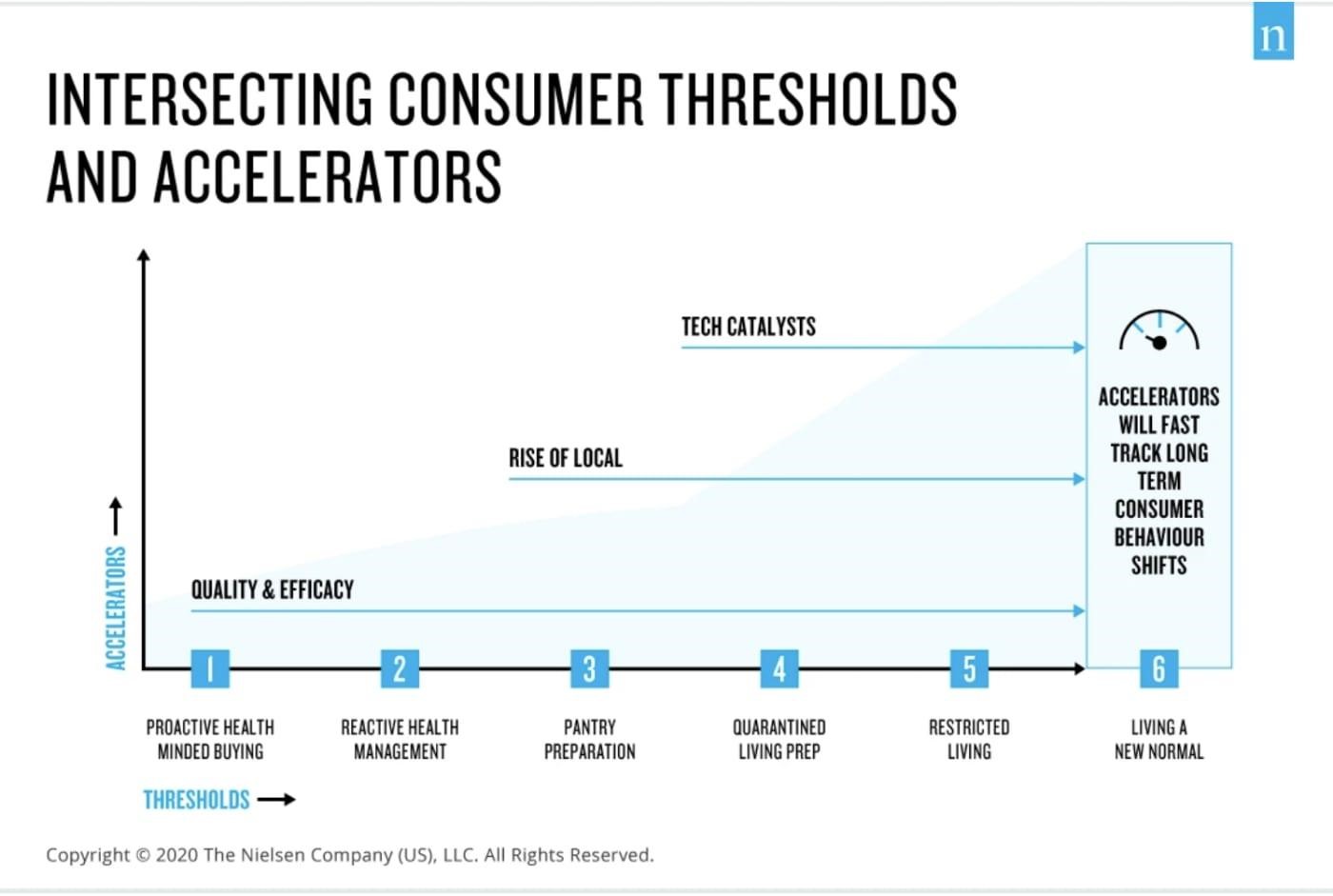There’s no denying that the COVID-19 global pandemic has changed the world of e-commerce. In our own personal lives as consumers, we’ve made shifts that were unthinkable just a couple of months ago. Sheltering in place, social distancing, and caring passionately about the health and well-being of our community are now an intrinsic part of our lives.
Nielsen identifies six thresholds that consumers are moving through globally as they progress through the stages of this pandemic.

In many countries, we’re in the early part of what Nielsen calls the “restricted living” stage. ECommerce businesses are already seeing a change in consumer preferences and shopping behaviors in this stage. While many of these are initially transitory, there also will be permanent changes in how consumers interact with your brand once they transition to the “living the new normal” stage. The new normal isn’t here yet, but it will be here – whether it’s weeks or months, once we start to venture outside more and more. Inevitably, brands that make investments in technology today to reimagine the customer experience online will find themselves better placed for the new normal than those that do not.
How should eCommerce businesses adapt for the new normal? Below we examine some of the adaptations needed in your digital media tech stack to prepare.
1. The Online Shopping Experience Has To Be As Visually Realistic And As Vividly Detailed As Possible
As millions of people around the world are now working or studying from home, consumers have greater motivation to shop online. While everyone admittedly loves shopping in-store, and we all love physically touching and feeling products, the consumer shifts to digital may be long-lived due to hygiene or health considerations, or even permanent as people integrate online shopping in their new routines.
The only experience a consumer may have of your product, then, is what you provide on your product details pages (PDPs). Already, brands that use life-like detail on their PDPs, with video showing how the shoe flexes or the fabric moves, experience higher engagement, better conversions, and lower product returns. This trend started with lifestyle and fashion brands well before the age of restricted living, but it hasn’t yet permeated to everyday essentials, consumer goods, electronics, and groceries. Simple images and, at most, spin sets worked for those products before, since there was some exposure to the product in-store. But in a world where the first (and often only) experience is online, that will no longer suffice. We recommend modernizing your PDPs with rich video and augmented visual experiences.
2. You Need To Be More Agile In Your Direct To Consumer Channel
In the face of adversity, consumer needs for products and their ability to spend can change overnight. While essentials like toilet paper, hand sanitizer, and groceries were at first top-of-mind during the quarantine living stage of the current pandemic, eventually in the restricted living stage the focus shifted to exercise apparel, educational aids for kids, craft projects, and even comfortable loungewear. As economic uncertainties hit many of us, demand, supply, and pricing all change dynamically. Your direct-to-consumer channel needs to be agile and ready to merchandise new products, reprice products, dynamically run sales, and change visual messages and tone to adapt to consumer sensitivities. Companies must ensure their e-commerce stack is flexible enough to provide superior business agility.
3. You Should Be Making Authentic Connections To Gain Trust And Loyalty
In this new normal, brands will need to make many changes to ensure an authentic connection with loyal consumers. Many of these are outside the realm of the digital experience – for example, social responsibility, local origin, and corporate citizenship. But there are a few changes possible in the realm of their digital media experience.
One easy win is to engage consumers by enabling user-generated images and video on your digital properties. This social proof can be a valuable tool to replicate the in-store social shopping visit. Of course, this requires some form of automation to assist with moderation, image, and video auto-cropping and enhancement for visual appeal, as well as many more digital considerations, including upload and delivery performance. But these are all technology investments that will pay off in the long run.
4. You Need To Make Your Distributed Digital Teams More Efficient
We’re living this now. Marketing, creative, and development teams are no longer co-located; they’re all working from home, juggling kids, pets, staying healthy, and working. There will be a time when we all return to offices, but something will have changed forever. Increasingly, teams will focus their retooling around more efficient workflows that enable truly globally distributed collaboration. Now is the time to invest in cloud-based technologies, such as organization-wide digital asset management, to manage your digital media assets centrally and create a single source of truth that is ideally suited for asynchronous team collaboration. You’ll also need better tools to ensure that repetitive media management tasks are automated, so they don’t require long round-trips to your creative or tech teams, thereby reducing bottlenecks.
5. Rich Media Management Should Be Consistent Through Your Magento Tech Stack
Integrating a best-of-breed media platform across your Magento stack will pay rich dividends in customer experience wins and consistent brand imagery that looks good and loads fast on every screen.
Recommended adaptation: Integrate a media management platform across your tech stack.
Key Takeaway
As consumers emerge into the new reality of living with COVID-19 in our midst, technology is a way forward for both consumers and businesses. Consumers are expecting better and richer digital experiences in the new normal. Brands that invest in their DTC competency today and deliver new experiences will be better prepared to connect with consumers in the new normal.




![How To Beat the Competition in DTC Ecommerce [Download] | Salsify](https://thegateway.net.au/wp-content/uploads/2022/11/how-to-beat-the-competition-in-dtc-ecommerce-download-salsify-768x384.png)
